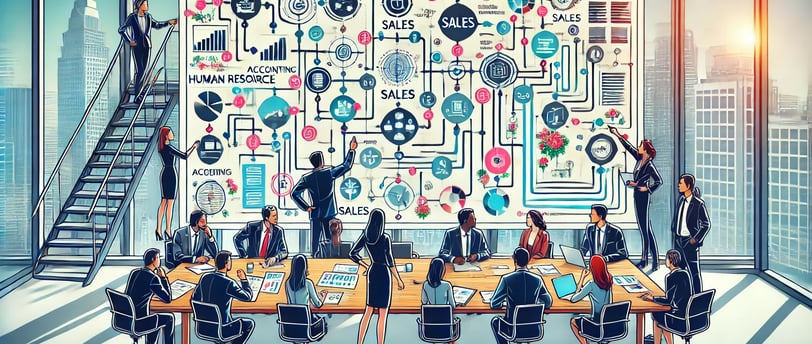Workflow from different perspectives
How to improve your workflow, what to pay attention to, and what to be aware of.
DESIGNBUSINESSDESIGN MANAGEMENTMANAGEMENTHIRING


How do you improve your workflow?
A workflow is a term for managing repetitive processes and tasks that occur in a particular order.
To improve a workflow you need to see it as is. Before you can see it you need to map it out. To map it you need to decide on the workflow that you want to improve. A company is a collection of workflows.
Most companies will have accounting in-house so that department has multiple workflows. Those could be invoicing, paychecks, various documentation, hiring, laying off, and others. For the sales team, it could be finding leads, qualifying leads, account management, etc.
I would recommend mapping your whole business to identify and prioritize which workflows to focus on first. This can be done by hiring a service designer.
If there is a task that needs doing there are steps to complete it. So choose a workflow that you want to focus on and get started. Write down who is involved, and what tasks must be done. Write the goal of the workflow.
I usually work backward, I write a goal and then work my way back to the start. Try thinking about this as going down the road from A to B. You can have 1 or more ramps that block your way. Each ramp has a scanner and unless you have a corresponding ticket you can't move on. So identify the "tickets" in your workflow.
Now you should have a rough line for your workflow that has people in it, tasks, and a clear path from A to B. From here you should observe how tasks are being done. Observe the people performing the tasks. Note the patterns, areas of concern, or something that piques your interest.
This could of course be as simple as seeing that people are using a workaround even though they have the tools to do a task. It could be seeing people use spreadsheets manually. It could be that it takes ages for something that should be done in minutes.
After you find a pattern, you have to investigate. On your own, or by talking to people and discovering more about the pattern. When you have sufficient information you should act on it. For the most part, it's an easy fix. For example, if you see a spreadsheet that people have to manually maintain. It's usually prone to errors, and they start using spreadsheets because of a lack of means.
So your solution to a spreadsheet is to turn that spreadsheet into a feature, you should observe the data. You should task a product designer to figure out what the feature is and where to implement it.
In one company where I worked, their accounting team had to keep tabs on which invoice was paid and which one wasn't. They had to send reminders, they had to create documentation, etc. And before you think, why not use an accounting solution that exists? The existing solutions did not cover their needs.
So my solution was simple, observe them and map their workflows. I put together a solution that automized emails to clients. Automized the outstanding balance reporting to the head of accounting. I have also automated document creation and reworked how clients are shown in the back office. So it was mapping multiple workflows. Prioritizing which ones needed to be improved first. And then putting my plan into action, wireframing, testing, and developing a solution.
If you are still unsure how to proceed feel free to schedule a call with me and let me get you on the right track. The following is an easy step-by-step that you can use as a guideline.
1 - Map Your Workflow
Identify the workflow
Choose the workflow you want to improve. This could be from any department, such as accounting, sales, or operations.
Example workflows include invoicing, payroll, lead generation, and account management.
Map the current state
Document the entire process as it is currently performed.
Identify who is involved and the tasks they perform.
Set a clear goal for the workflow.
2 - Analyze the workflow
Work backwards
Start from the goal and work backward to identify all steps needed to reach it.
Think of the workflow as a journey from point A to point B, with potential "ramps" (obstacles) that need specific "tickets" (solutions) to pass.
Observe and note patterns
Observe how tasks are being completed.
Identify inefficiencies, such as manual workarounds, excessive use of spreadsheets, or tasks that take longer than they should.
3 - Investigate and identify issues.
Research patterns
Investigate the root causes of inefficiencies.
Talk to employees to understand their challenges and gather insights.
Prioritize issues
Focus on the most critical issues that will have the greatest impact on efficiency.
4 - Develop solutions
Implement easy fixes
Automate email communications: Tools like Mailchimp or HubSpot can be used to automate routine emails such as follow-ups and newsletters, ensuring timely communication without manual effort.
Standardize document templates: By creating standardized templates for documents like invoices and reports, you can reduce the time spent on formatting and ensure consistency across all communications.
Use project management software: Tools like Trello or Asana help organize tasks, set deadlines, and track progress, reducing the need for manual updates and improving team collaboration.
Design solutions to complex problems
For more complex issues, such as automating email communications and balance reporting, create detailed plans and prototypes.
Work with a product designer to develop new features or systems where necessary.
5 - Test and implement
Prototype and test
Develop prototypes of your solutions and test them in a controlled environment.
Gather feedback and make necessary adjustments.
Roll out and monitor
Implement the solution across the organization.
Monitor the new workflow to ensure it operates smoothly and achieves the desired improvements.
6 - Continuous improvement
Regularly review workflows to identify new areas for improvement.
Stay updated with new tools and technologies that can further enhance efficiency.
Your workflow and hiring
How your workflow clouds your judgement when hiring?
When you are used to doing things a certain way it's hard to see a different way. This applies to hiring in a special way. When companies get started they struggle to get to their goals. They slowly build workflows. The initial workflows usually get refined, and more complex as the company grows. Most companies start being dependent on the old ways.
Now you are a company that wants to get new people. New talent. When you are after junior talent you can mould them into your ways. You can teach them your workflows. A great opportunity for growth is to listen to their suggestions and see if they have any merit.
If you are looking for more experienced people, you have to have a different approach. You have your way of doing things and they have theirs. You need to be crystal clear on what you expect from them. Your goals have to be clear. You must allow them to work at their own pace and give them time to adapt to your ways of working.
The important part of hiring is to be open-minded. When somebody applies you ask them questions from your perspective. You are hiring people for a purpose. You want designers to solve issues, you want developers to be creative.
If you come at people with your perspective how will you know if they are good at their jobs? If your workflow sucks, and it usually does to a certain extent, how can you judge somebody else by your standards? How can you ascertain if a person is a good fit without even talking to them? You should be open to other people's opinions and you should not be dismissive, you should keep your questions open-ended. You cannot devise a test for a human being for a job that requires teamwork and context.
In IT you have context, and you are expecting people to perform according to your perspective. You are pulling them out of context and giving them a task to judge what exactly? Again if you want to test somebody, do a proper test, 2 two-week paid project, and see if it works.
To sum it up, rethink your hiring process. It's a workflow and it can also be optimized. Focus on why you are hiring, how much you can pay, and what you want in return.


Identifying opportunities to improve workflows in your company
Simple stupid advice and things you could avert your attention to
New hire
If it's a junior new hire - they can offer a new perspective on your work - this is an excellent opportunity to see how people see your workplace and workflows. You will also see opportunities how to better onboard new hires.
More experienced new hires - they can often see solutions to problems you were not even aware of. This is because of their past experience, so you should not dismiss their observations.
Contractors - they usually have a myriad of experiences and can be eye-opening to some companies. Their experience might come across as arrogance so try to look past that and give their observations a chance.
Workarounds
People will always find the easiest way to accomplish their work. This is a golden opportunity for your company. You can usually turn this workaround into a solution. This benefits you in more than one way. Your employees will be happy that you made it easier for them to do their jobs, and your company will usually profit more.
You can also discover issues in the workflows which can point you to solutions. Usually, workarounds mean that people don't want to use an existing solution because it's too hard to use. Or it means that a solution does not exist. All in all it's an opportunity for you.
Feedback
You will learn more from negative feedback than from positive. And people are usually more chatty when they are at the extremes of satisfaction.
Very positive feedback can teach you about what people love about your company. It can teach you what you should keep focusing on, and you can improve the sales flow. You can also improve the client/customer management.
The negative feedback can teach you a lot about where the mistakes are and how to fix them. People who have negative feedback will be open to giving you feedback because they feel wronged. And you can turn them around by simply talking to them and listening. You can also see if there is any way of turning their negative into positive experiences.
Any feedback is great feedback and you should be documenting it, and using it to improve your workflows.
Streamlining workflows is crucial for boosting efficiency and satisfaction within your organization. By mapping existing processes and incorporating insights from diverse personnel, we can identify and rectify inefficiencies. Utilizing feedback and innovative solutions, we can transform everyday challenges into opportunities for growth. Let’s collaborate to refine your workflows and achieve optimal performance.
Contact me to optimize your business processes and turn potential into real progress.


